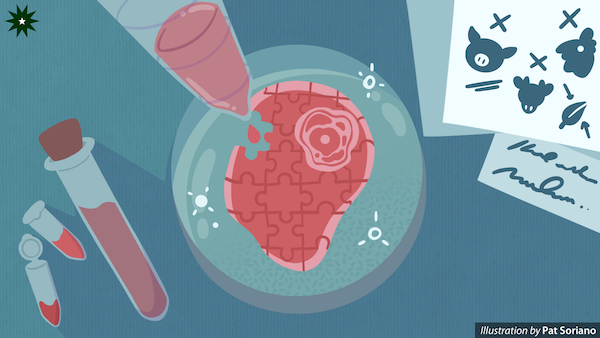
In humanity’s efforts for survival, our ancestors have identified natural resources available for human consumption. However, the finite quality of these resources has pushed scientists to explore sustainable substitutes, one example being laboratory-grown meat.
Scientific developments have made it possible to innovate processes by which animals could be spared from consumption. Tissue engineering closes the gaps between engineering and life sciences to produce biological substitutes by focusing on generating certain tissues in a laboratory-controlled environment for optimal production rates, quality, and characteristics.
The technology is commonly used to maintain and restore damaged organ tissues in medicine but is now being used to develop the food industry. As such, these developments have paved a way for further discussions on chemical wastes and ethical principles in complex sciences—concepts typically disregarded in the name of industrialization.
Backing the groundwork
Cultured meat production, one of the applications of tissue engineering technology, enables animal meat to be recreated in laboratories using cells from animals, typically cows and chickens. During this process, scientists wait until the fibers have grown into a sizable amount characterized by a certain appearance, texture, flavor, and nutritional content before collecting the meat substitute.
“One of the key opportunities [in lab-grown meat] [is] medicinal foods,” explains Kevin Kit Parker, a professor of Harvard University School of Engineering and Applied Sciences. By growing them under certain conditions, researchers are able to modify the presence of nutritional components that are not typically found in conventional meat.
Because of this unique production process, there are endless possibilities for scientists to alter and improve the nutritional characteristics of the meat. The heavy and strategically-placed regulations controlling meat production enable researchers to incorporate the meat with supplementary nutrients such as greater amounts of protein, different types of fats, and essential minerals.
Parker cites that a healthier way to construct meat is to incorporate fish fat in beef, which makes the meat have a fair share of both protein and fatty acids that are beneficial for brain and heart health.
Stretching the apparatus
Different techniques are currently being tested for cultured meats to possess similar characteristics to conventional meat.
However, several factors have to be taken into account in the intricacies of the production process, especially in the developing stages. “Cell sourcing and tissue scaffolding are the two biggest [processes behind lab-grown meat]. The quality control on its nutritional value and mass production of the product [have to be considered as well],” states Parker.
The quality of the end product largely depends on the sourcing and maintenance of animal cells. Adult cells from animals are selected and placed on a specified scaffold or medium, where they are provided with the necessary salts, sugars, and proteins to stimulate growth.
However, the type of medium utilized could still change the quality and production rates of the cultured meat itself. The limited selection of available cell culture media makes this of greater concern, regardless of the controlled laboratory environments. “The mass production of cells for tissue-engineered meat is one of the challenges in cellular agriculture,” Parker states.
Further on the cell culture media and maintenance of the environment, Parker expounds on the challenges regarding the antibiotic content of cultured meat.
To prevent infections and bacterial contaminations in the cellular environment, Parker points out that most cell biologists put antibiotics in their cell media. However, “antibiotics can have various effects on the cellular development within tissues […] and there is the challenge of using antibiotics to the point that [it] strains bacteria [to] evade their biocidal effects,” he furthers.
This makes the idea of cultured meat being antibiotic-free a “tricky idea”—regardless of full consideration of controlled conditions.
While the risks of antibiotics in meat are still being calculated, one may be comforted by how the presence of antibiotics in cultured meat is still considerably less than in conventional meat.
Engineering ethical principles
While lab-grown meat may be a more sustainable option than conventional meat, it is not exempt from its own shortcomings. The developing technology used to create lab-grown meat presents not only technical concerns but also moral and ethical dilemmas.
While the production of cultured meat excludes the need for slaughterhouses, it still requires living animal cells, which, as some argue, violate animals’ rights in accordance with using them for research purposes with the benefit of their lack of consent.
Moreover, the effects of cultured meat production on climate change have also been raised. Lab processes may potentially exacerbate greenhouse gas emissions and cause an increase in the emergence of common chemical and organic molecules which are used for the proliferation of the cells themselves. “For the bioengineers, there is a tremendous opportunity with important global health and climate impacts,” the professor affirms.
These assumptions, however, are being made with regard to tissue engineering’s infancy and developmental stages. Such hurdles are standing at a hopeful edge of being eliminated as the technology matures.
Characterizing potential
Due to the difficulty of weighing its technical and ethical aspects, it is safe to say it may take a while for cultured meat to hit the supermarkets.
“There is a lot of work to do,” Parker stresses. However challenging these issues might be, Parker and other researchers believe that cultured meat is on its path to starting a sustainable revolution—one which does not kill for human consumption at the expense of global health, climate change, ethics, and energy efficiency.
